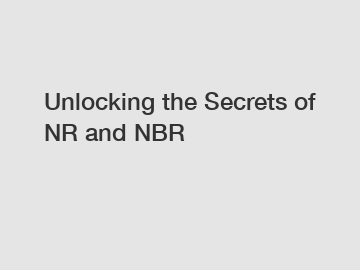Unlocking the Secrets of NR and NBR
Unlocking the Secrets of NR and NBR.
Natural Rubber (NR) and Nitrile Butadiene Rubber (NBR) are two of the most commonly used synthetic rubbers in various industries today. NR is derived from the sap of rubber trees, while NBR is a type of synthetic rubber that offers excellent resistance to oils, fuels, and chemicals. Understanding the properties and characteristics of these materials is essential for selecting the right type of rubber for a particular application.
Properties of NR.

Natural Rubber, or NR, is known for its excellent elasticity and resilience. It is highly flexible and has good tear strength, making it ideal for applications that require high tensile strength and resistance to abrasion. NR also offers good resistance to wear and is resistant to water and moisture. However, it is not recommended for use in applications that involve exposure to oils, solvents, or chemicals, as it can degrade over time.
Properties of NBR.
Nitrile Butadiene Rubber, or NBR, is a synthetic rubber that is well-suited for applications that require resistance to oils, fuels, and chemicals. NBR has excellent resistance to abrasion, tearing, and punctures, making it a popular choice for gaskets, seals, and O-rings in automotive and industrial applications. NBR also offers good flexibility and low-temperature resistance, making it suitable for use in a wide range of temperatures.
Differences between NR and NBR.
While both NR and NBR offer excellent elasticity and flexibility, there are some key differences between the two materials. NR is a natural rubber derived from plants, while NBR is a synthetic rubber produced from petrochemicals. NBR offers superior resistance to oils, fuels, and chemicals compared to NR, making it the preferred choice for applications that involve exposure to these substances. On the other hand, NR is more environmentally friendly and biodegradable than NBR, making it a more sustainable choice for certain applications.
Applications of NR and NBR.
NR is commonly used in applications that require high elasticity and resilience, such as tires, conveyor belts, and footwear. NBR, on the other hand, is widely used in applications that require resistance to oils, fuels, and chemicals, such as seals, gaskets, and O-rings in automotive and industrial equipment. Both NR and NBR can be modified with additives to enhance their properties and meet specific application requirements.
Conclusion.
In conclusion, NR and NBR are two versatile materials that offer unique properties and characteristics for a wide range of applications. By understanding the properties of these materials, engineers and designers can select the right type of rubber for their specific needs. Whether you need high elasticity and resilience or resistance to oils and chemicals, NR and NBR have you covered.
Contact us.
If you have any questions or would like to learn more about NR and NBR, please do not hesitate to contact us. Our team of experts is here to help you find the perfect solution for your rubber material needs.
If you want to learn more, please visit our website round rubber block, round rubber gasket manufacturer, gasket vs oring.
97
0
0


Comments
All Comments (0)